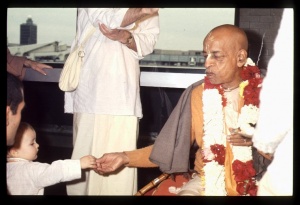CC Adi 12.86 (1975)

A.C. Bhaktivedanta Swami Prabhupada
TEXT 86
- śrīharṣa, raghu-miśra, paṇḍita lakṣmīnātha
- baṅgavāṭī-caitanya-dāsa, śrī-raghunātha
SYNONYMS
śrīharṣa—of the name Śrīharṣa; raghu-miśra—of the name Raghu Miśra; paṇḍita lakṣmīnātha—of the name Lakṣmīnātha Paṇḍita; baṅgavāṭī-caitanya-dāsa—of the name Baṅgavāṭī Caitanya dāsa; śrī-raghunātha—of the name Śrī Raghunātha.
TRANSLATION
The twenty-third branch was Śrīharṣa; the twenty-fourth, Raghu Miśra; the twenty-fifth, Lakṣmīnātha Paṇḍita; the twenty-sixth, Baṅgavāṭī Caitanya dāsa; and the twenty-seventh, Raghunātha.
PURPORT
Raghu Miśra is described in the Gaura-gaṇoddeśa-dīpikā, verses 195 and 201, as Karpūra-mañjarī. Similarly, Lakṣmīnātha Paṇḍita is mentioned as Rasonmādā, and Baṅgavāṭī Caitanya dāsa is mentioned as Kālī. The Śākhā-nirṇaya states that Baṅgavāṭī Caitanya dāsa was always seen with eyes full of tears. He also had a branch of descendants. Their names were Mathurāprasāda, Rukmiṇīkānta, Jīvanakṛṣṇa, Yugalakiśora, Ratanakṛṣṇa, Rādhāmādhava, Ūṣāmaṇi, Vaikuṇṭhanātha and Lālamohana, or Lālamohana Śāhā Śāṅkhānidhi. Lālamohana was a great merchant in the city of Dacca. The Gaura-gaṇoddeśa-dīpikā, verses 194 and 200, mentions that Raghunātha was formerly Varāṅgadā.